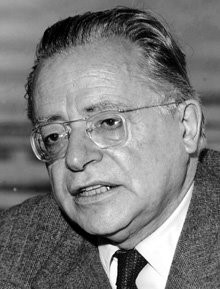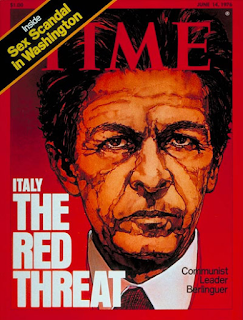Son of future president who defied Fascists
 |
| Giulio Einaudi ran his publishing company for more than 60 years |
The son of Luigi Einaudi, an anti-Fascist intellectual who would become the second President of the Italian Republic, Giulio was also the father of the musician and composer Ludovico Einaudi.
Giulio Einaudi’s own political leanings were influenced by his education at the the Liceo Classico Massimo d'Azeglio, where his teacher was Augusto Monti, a staunch opponent of Fascism who was imprisoned by Mussolini’s regime in the 1920s.
After enrolling at the University of Turin to study medicine, Einaudi decided to abandon his studies to work alongside his father Luigi in publishing an anti-Fascist magazine Riforma Sociale - Social Reform.
His own contribution was to establish a cultural supplement, edited by the writer and translator Cesare Pavese, which so offended Mussolini that in 1935 the magazine was closed down and the staff arrested.
Einaudi spent 45 days in jail along with Pavese and several writers who would later become celebrated names, including Vittorio Foa, Massimo Mila, Carlo Levi and Norberto Bobbio.
 |
| The publisher's famous ostrich logo is still on the cover of every Einaudi publication |
The first book to carry the company’s famous ostrich emblem - borrowed from the magazine - was a translation - by his father - of Henry A. Wallace's What America Wants, an analysis of New Deal economics. Mussolini apparently approved of the substance of the book but not of Luigi Einaudi’s foreword.
 |
| Luigi Einaudi, Giulio's father, was the 2nd President of the Italian Republic |
This was despite being damaged in bombing raids on Turin and Giulio’s decision to decamp temporarily to Switzerland, from where he returned to support the resistance movement in Piedmont.
Once the Fascists had been overthrown, the business grew quickly. Einaudi was well placed to feed the literary needs of a nation embracing a left-wing renaissance and although the publisher had a close relationship with many leading members of the PCI, many literary historians have argued that Einaudi was already the father of left-wing culture in Italy and that his writers influenced the PCI rather than other way round.
At the same time, Einaudi had an eye for spotting young talent, publishing authors such as Natalia Ginsburg, Elsa Morante, Italo Calvino and Primo Levi while they were still unknown.
When Giulio Einaudi Editore celebrated its 50th anniversary in 1983, it had published more than 5,000 titles, its back catalogue representing a history of 20th century Italian literature, with Carlo Emilio Gadda, Leonardo Sciascia and the poet Eugenio Montale also among his authors.
 |
| The composer and pianist Ludovico Einaudi is Giulio's son |
Known as Il principe (the prince) because of his distinguished appearance, his biggest failing was that he spent money as if he were royalty. Seldom would he reject a project on the grounds of cost and years veering from one financial crisis to another came to head in 1994, when his bankers ran out of patience and the need for outside investment led to the company being taken over by Mondadori, the publishing conglomerate controlled by the right-wing former prime minister Silvio Berlusconi, although Einaudi remained chairman.
Einaudi enjoyed Rome as much as Turin and died at his country house just outside the capital in April 1999, aged 87. He was survived by his wife, Renata Aldrovandi, sons Mario, Riccardo and Ludovico, and a daughter, Giuliana.
 |
| Dogliani's imposing church of Sant Quirico and Paolo, designed by Giovanni Battista Schellino |
Einaudi’s home town of Dogliani, where there has been a settlement since pre-Roman times, is about 60km (37 miles) southeast of Turin in the Langhe, a picturesque area of hills to the south and east of the Tanaro river famous for wines, cheeses and truffles. As well as being the home of the red wine Dolcetto di Dogliani, the town is famous for the annual tradition of Presepio Vivente, in which around 350 people take part in a living nativity scene in the medieval streets. The town is also notable for the magnificent parish church of Santi Quirico and Paolo, designed by Giovanni Battista Schellino. The Einaudi home, a farmhouse just outside the town called San Giacomo, was acquired by Luigi Einaudi in 1897 and became the heart of the family’s wine-producing business.
 |
| Rome's Isola Tiberina used to be one of Giulio Einaudi's favourite places in the capital |
When in Rome, Giulio Einaudi would often be spotted at a table outside a cafe in Piazza Navona or, in the summer months, on the Isola Tiberina, situated in the bend in the Tiber that wraps around the Trastevere district, with which it is connected by the Ponte Cestio. A footbridge allows access from the other bank of the river. The island was once the location of an ancient temple to Aesculapius, the Greek god of medicine and healing, and in modern times the Fatebenefratelli Hospital, founded in the 16th century. The 10th century the Basilica of St. Bartholomew is also located on the island, which is just 270m (890ft) long and 67m (220ft) wide.
Find a hotel in Rome with TripAdvisor
More reading:
Cesare Pavese, the author whose translations introduced Italy to the great American writers of the 20th century
How the murder Giacomo Matteotti changed the mind of Luigi Einaudi
Antonio Gramsci - the Communist intellectual Mussolini could not gag
Also on this day:
533: Pope John John II is the first pontiff not to us his own name
1462: The birth of painter Piero di Cosimo
1909: The birth of mountaineer Riccardo Cassin
Home











